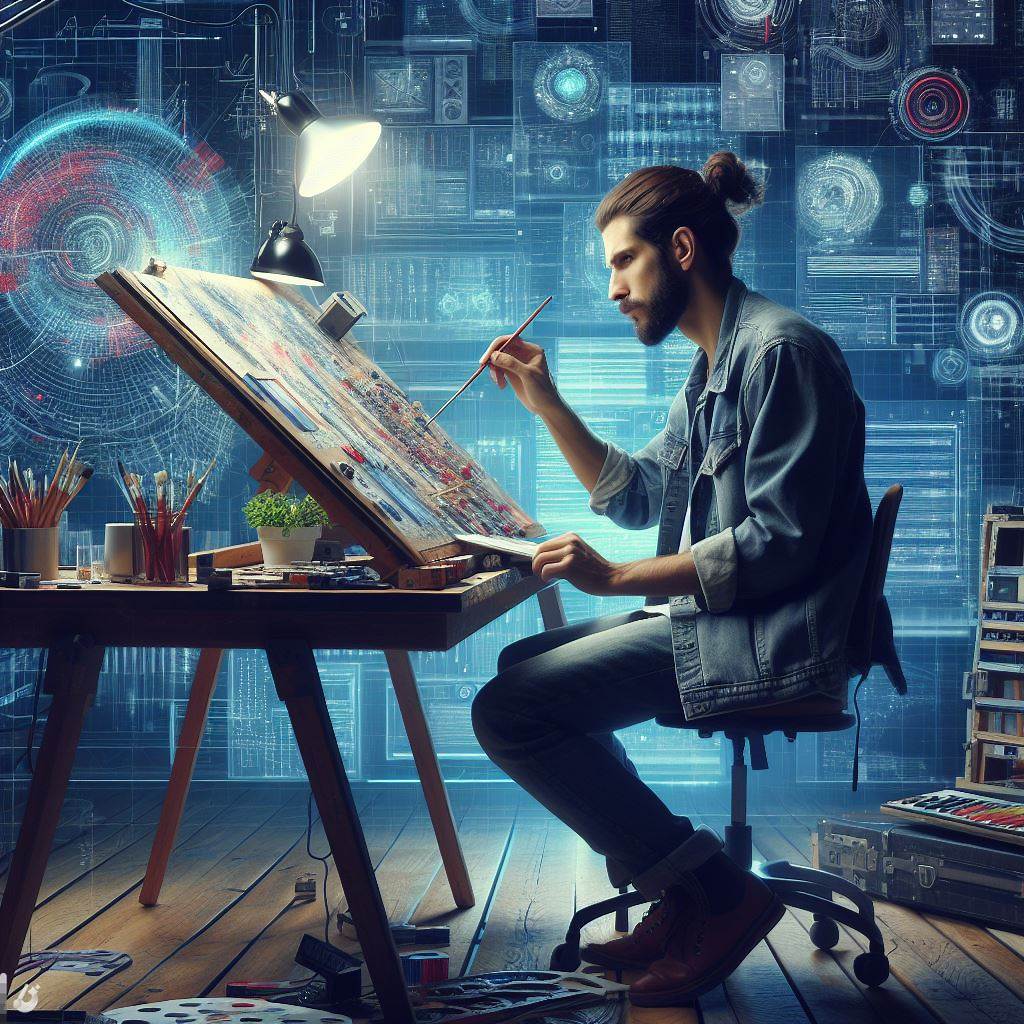Introduction
Technology has revolutionized various sectors, including the art world.
In Canada, artists are utilizing technology to innovate and redefine the art scene in the country.
The fusion of art and technology has led to groundbreaking works of art that push the boundaries of creativity and imagination.
From virtual reality installations to interactive sculptures, the possibilities are endless when art and technology converge.
In this blog post, we will explore the significance of art and technology in Canada and how Canadian artists are using technology to create impactful works of art.
We will also discuss the challenges and opportunities that come with the fusion of art and technology.
By the end of this post, you will have a better understanding of how technology is changing the art scene in Canada and how Canadian artists are leading the way in innovation and creativity.
So, let’s dive in and explore the exciting world of art and technology in Canada!
Historical perspective on art and technology
The influence of technology on art throughout history
- Technological advancements have continuously shaped and revolutionized the art world.
- In the Renaissance period, the invention of oil painting techniques transformed the art scene.
- The invention of the camera in the 19th century challenged traditional artistic representation.
- The Industrial Revolution introduced new materials and techniques, expanding artistic possibilities.
- Modernist movements like Dada and Futurism embraced technology as a means of artistic expression.
Early examples of Canadian artists incorporating technology into their work
- Canadian artist Jean-Paul Riopelle experimented with printmaking techniques in the 1950s.
- Greg Curnoe incorporated found objects, such as bicycle wheels, into his paintings in the 1960s.
- Michael Snow explored multimedia installations and experimental film during the 1970s.
- Iain Baxter’s early works incorporated mass-produced objects, blurring the line between art and industry.
- Lynn Hershman Leeson utilized technology to address feminism and identity in the 1980s.
The impact of technology on the art industry in Canada
- Technological advancements have provided new tools and mediums for Canadian artists to explore.
- Digital art has emerged as a prominent form of expression, blurring traditional boundaries.
- The internet has democratized the art world, allowing artists to reach global audiences with ease.
- Virtual reality and augmented reality have opened up immersive experiences for art consumers.
- Technology has facilitated collaborations among artists, fostering innovation and creative exchange.
The influence of technology on art throughout history
The relationship between art and technology in Canada is a dynamic and ever-evolving one.
Throughout history, technological advancements have played a crucial role in shaping the art world, pushing boundaries, and expanding possibilities for artistic expression.
In the Renaissance period, artists embraced the invention of oil painting techniques, which allowed for more vibrant colors, finer details, and greater realism.
As technology progressed, the invention of the camera challenged traditional modes of artistic representation, leading artists to explore new ways of capturing and depicting the world.
With the Industrial Revolution came new materials and techniques, giving rise to movements like Impressionism and Cubism.
These artists embraced industrialization and mechanization, incorporating elements of modern life into their works.
The integration of technology into art became even more pronounced with the rise of modernist movements such as Dada and Futurism, which celebrated the machine age and sought to redefine art in the context of technological advancement.
Early examples of Canadian artists incorporating technology into their work
In Canada, several artists have been at the forefront of incorporating technology into their work.
Jean-Paul Riopelle, a prominent Canadian artist, experimented with printmaking techniques in the 1950s, pushing the boundaries of traditional artistic mediums.
Greg Curnoe incorporated found objects, such as bicycle wheels, into his paintings, blurring the line between art and everyday life.
During the 1970s, artists like Michael Snow and Iain Baxter employed multimedia installations and incorporated mass-produced objects into their works, exploring the intersections of art, technology, and consumer culture.
Lynn Hershman Leeson utilized technology to address feminist themes and explore the concept of identity.
The impact of technology on the art industry in Canada
In the contemporary art scene, technology continues to reshape the industry in Canada.
Digital art has emerged as a prominent form of expression, with artists exploring the possibilities of virtual environments, interactive installations, and algorithmic creations.
The internet has democratized the art world, providing artists access to global audiences and allowing for direct engagement between artists and viewers.
Advancements in virtual reality and augmented reality have opened up new avenues for immersive art experiences, blurring the boundaries between the physical and virtual worlds.
Canadian artists are leveraging these technologies to create innovative and interactive installations, engaging viewers on a sensory and intellectual level.
Unlock Your Career Potential
Visualize a clear path to success with our tailored Career Consulting service. Personalized insights in just 1-3 days.
Get StartedFurthermore, technology has facilitated collaborations among artists, allowing for cross-disciplinary projects and the exchange of ideas.
Artists are tapping into the diverse skill sets and perspectives of technologists, scientists, and engineers, pushing the boundaries of what art can be.
Generally, the historical perspective on art and technology reveals a symbiotic relationship that has shaped the art scene in Canada.
Technological advancements have constantly influenced artistic practice, enabling new forms of expression, challenging societal norms, and expanding the possibilities of visual communication.
As technology continues to evolve, Canadian artists will undoubtedly push the boundaries of art further, creating innovative and transformative works that reflect our ever-changing world.
Read: Emerging Art Trends in Canada for 2024-2024
The fusion of traditional art forms with technology
Technology has become an integral part of our lives, taking over various aspects including the field of art.
The fusion of traditional art forms with technology has given birth to innovative and captivating creations.
In Canada, numerous artists have embraced this trend and are making significant contributions to the art scene.
Exploration of different art forms in Canada that incorporate technology
Digital photography and image manipulation
The exploration of different art forms in Canada that incorporate technology is revolutionizing the way we perceive and create art.
One such form is digital photography and image manipulation.
Canadian artists are utilizing advanced digital techniques to produce stunning visuals that push the boundaries of traditional photography.
By experimenting with various editing tools and software, they bring new dimensions to their work, creating captivating and thought-provoking images.
Augmented reality and virtual reality in visual arts
Another art form that has gained immense popularity in Canada is the integration of augmented reality (AR) and virtual reality (VR) in visual arts.
Artists are using these immersive technologies to create interactive experiences for the viewers.
Through the use of specialized devices, the audience can explore virtual worlds, interact with objects, and experience art in a whole new way.
Canadian artists are pushing the limits of AR and VR, creating mind-bending and transformative artworks that leave a lasting impact on the audience.
Interactive installations and multimedia experiences
Interactive installations and multimedia experiences are also prominent art forms in Canada that employ technology.
These artworks provide an interactive and engaging experience by combining various elements such as sound, visuals, and technology.
Artists create immersive environments where the viewers become an active part of the artwork, blurring the line between the observer and the observed.
These installations often challenge conventional concepts of art and invite viewers to actively participate and explore different narratives.
Prominent Canadian artists embracing these techniques
Examples of innovative Canadian photographers
Many Canadian artists have embraced these techniques and have gained recognition for their innovative approach.
In the realm of photography, artists like Edward Burtynsky and Jeff Wall have pushed boundaries by experimenting with digital manipulation and new media.
Their work challenges traditional photography, incorporating technology to explore complex themes and tell compelling visual stories.
Notable Canadian artists using augmented reality and virtual reality
In the domain of augmented reality and virtual reality, Canadian artists such as Chris Milk and Jeremy Bailey have made significant contributions.
They have created immersive experiences that transport viewers into alternate realities, challenging traditional notions of space and time.
Their use of advanced technologies and storytelling techniques has earned them international acclaim.
Recognized creators of interactive installations and multimedia experiences
Furthermore, recognized creators of interactive installations and multimedia experiences like Rafael Lozano-Hemmer and Janet Cardiff have gained widespread appreciation.
Their installations combine technology with various artistic elements to create captivating and participatory experiences.
By utilizing sound, video, and interactivity, they engage the viewers on multiple sensory levels and blur the boundaries between the physical and the virtual.
Essentially, the fusion of traditional art forms with technology has transformed the art landscape in Canada.
Through the exploration of digital photography, augmented reality, virtual reality, and interactive installations, Canadian artists are pushing boundaries, creating captivating and transformative artworks.
These innovative approaches have gained recognition both nationally and internationally, cementing Canada’s position as an epicenter for art and technology innovation.
Read: Indigenous Art in Canada: Voices and Visions

Technology as a medium for artistic expression
The role of technology in expanding the possibilities of artistic expression
Technology has revolutionized the way artists express themselves, enabling them to push boundaries and explore new realms.
Innovative tools and software have expanded the traditional definition of art, allowing for interdisciplinary collaborations.
Digital platforms have democratized art by giving artists access to a global audience, transcending geographical boundaries.
Canadian artists leveraging technology to communicate their ideas
Canadian artists are harnessing technology in remarkable ways to convey their ideas and connect with audiences.
- Use of social media platforms and online communities: Social media platforms like Instagram and Facebook have become virtual galleries, promoting artists’ work internationally. Artists are leveraging these platforms to showcase their art, build a following, and engage in meaningful dialogues with their audience.
- Creation of digital art and web-based projects: Through digital art, Canadian artists are experimenting with new mediums, blurring the line between art and technology. Web-based projects offer interactive experiences for viewers, challenging traditional notions of art consumption.
Impact of technology on the accessibility and distribution of art in Canada
Technology has significantly impacted the accessibility and distribution of art throughout Canada.
Artists can now reach audiences beyond major cities through online platforms and digital exhibitions.
Digital distribution allows for greater exposure, facilitating the discovery of emerging Canadian artists by a global audience.
Increased accessibility has sparked an inclusive dialogue within the art community, inviting diverse perspectives and collaborations.
In general, technology has become an essential medium for artistic expression, expanding the possibilities available to Canadian artists.
Through social media and online communities, artists can reach larger audiences and engage in dialogues that transcend physical limitations.
Additionally, the creation of digital art and web-based projects enables artists to explore new mediums and challenge traditional forms.
The accessibility and distribution of art have been greatly improved, allowing for a more inclusive and diverse art scene in Canada.
As technology continues to evolve, so too will the innovative ways in which artists leverage it to communicate their ideas and push the boundaries of artistic expression.
Read: Balancing Art and Business: Tips for Canadian Artists
Uncover the Details: Casting Calls in Canada: What You Need to Know
You Might Also Like: Interview Techniques from Top Reporters
Challenges and Opportunities for Canadian Artists Using Technology
Concerns Regarding the Authenticity of Technologically Driven Art
- Artists using technology face skepticism from traditional art enthusiasts about the authenticity of their work.
- They must emphasize the creativity and unique artistic vision behind their technologically-driven art.
- By explaining their creative process and intentions, artists can address concerns and gain acceptance.
- Artists can also organize exhibitions and events to showcase their technologically driven artwork to a wider audience.
- Engaging in dialogue with critics and the public can help demystify and legitimize technologically-driven art forms.
Copyright and Intellectual Property Issues in the Digital Age
- Advancements in technology have made it easier to copy and distribute artistic content without permission or attribution.
- Canadian artists must protect their digital creations by understanding copyright laws and licensing agreements.
- Artists can utilize online platforms that offer secure distribution and monetization of their digital artworks.
- Collaborating with legal professionals can help artists safeguard their intellectual property rights in the digital landscape.
- Through education and awareness, artists can navigate the complexities of copyright in the digital age.
Digital Divide in Access to Technology for Artists
- Not all Canadian artists have equal access to technology due to socioeconomic factors and geographical location.
- There is a need for initiatives that provide affordable or free access to technology and digital tools for artists.
- Government funding and partnerships with technology companies can help bridge the digital divide for artists.
- Artists can form collectives and share resources to overcome financial barriers and lack of technology access.
- By collaborating with organizations and communities, artists can advocate for inclusivity and equal access to technology.
In essence, Canadian artists utilizing technology face challenges regarding the authenticity of their work, navigate copyright and intellectual property issues, and confront the digital divide.
However, these challenges also present opportunities for artists to showcase their creative vision, protect their rights, and advocate for equal access to technology.
Through dialogue, education, and collaboration, Canadian artists can continue to innovate and shape the intersection of art and technology in Canada.
Read: Art Therapy: A Growing Trend in Canadian Wellness
Conclusion
Art and technology have become increasingly intertwined in Canada’s art scene.
The fusion of these two fields has led to innovative and groundbreaking works of art that push the boundaries of creativity and imagination.
Canadian artists have embraced technology as a tool for artistic expression, and the results have been nothing short of remarkable.
It is essential for Canadian artists to continue innovating and exploring new possibilities through technology.
By doing so, they can create works of art that are both meaningful and impactful.
The future of art and technology in Canada is bright, and it holds immense potential for artists who are willing to take risks and experiment with new ideas.
As technology continues to evolve, so will the art scene in Canada. It is an exciting time to be an artist in Canada, and the possibilities are endless.
In a nutshell, let us celebrate the fusion of art and technology and encourage Canadian artists to continue pushing the boundaries of creativity and innovation.
By doing so, we can create a more vibrant and inclusive art scene that reflects the unique identity and values of our country.




